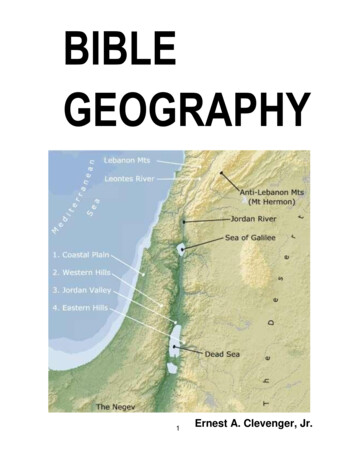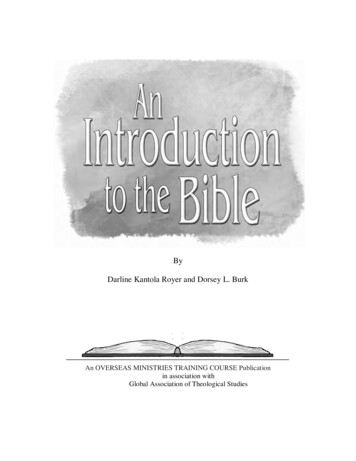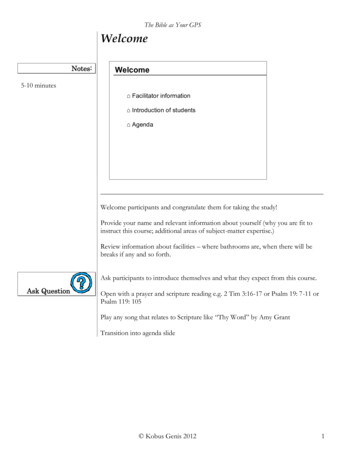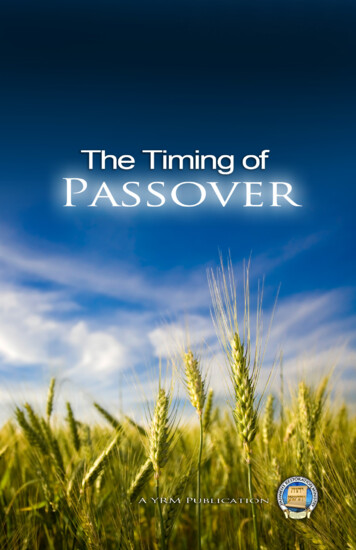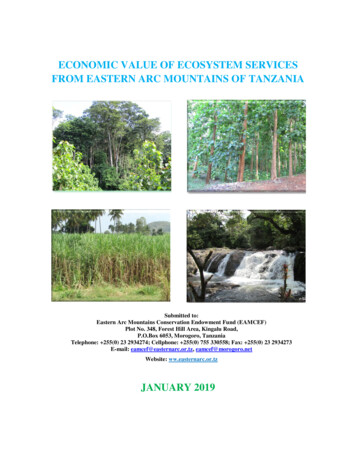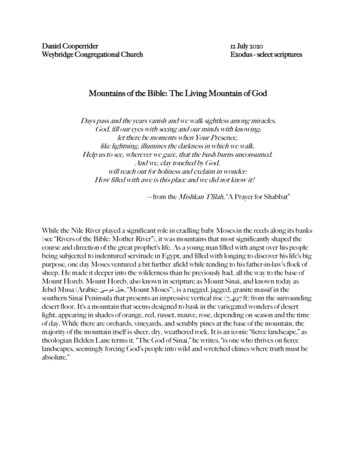
Transcription
Daniel CooperriderWeybridge Congregational Church12 July 2020Exodus - select scripturesMountains of the Bible: The Living Mountain of GodDays pass and the years vanish and we walk sightless among miracles.God, fill our eyes with seeing and our minds with knowing;let there be moments when Your Presence,like lightning, illumines the darkness in which we walk.Help us to see, wherever we gaze, that the bush burns unconsumed.And we, clay touched by God,will reach out for holiness and exclaim in wonder:How filled with awe is this place and we did not know it!—from the Mishkan T’filah, “A Prayer for Shabbat”While the Nile River played a significant role in cradling baby Moses in the reeds along its banks(see “Rivers of the Bible: Mother River”), it was mountains that most significantly shaped thecourse and direction of the great prophet’s life. As a young man filled with angst over his peoplebeing subjected to indentured servitude in Egypt, and filled with longing to discover his life’s bigpurpose, one day Moses ventured a bit further afield while tending to his father-in-law’s flock ofsheep. He made it deeper into the wilderness than he previously had, all the way to the base ofMount Horeb. Mount Horeb, also known in scripture as Mount Sinai, and known today asJebel Musa (Arabic: ﺳٰﻰ َ َﺟﺒَﻞ ُﻣﻮ , “Mount Moses”), is a rugged, jagged, granite massif in thesouthern Sinai Peninsula that presents an impressive vertical rise (7,497 ft) from the surroundingdesert floor. It’s a mountain that seems designed to bask in the variegated wonders of desertlight, appearing in shades of orange, red, russet, mauve, rose, depending on season and the timeof day. While there are orchards, vineyards, and scrubby pines at the base of the mountain, themajority of the mountain itself is sheer, dry, weathered rock. It is an iconic “fierce landscape,” astheologian Belden Lane terms it. “The God of Sinai,” he writes, “is one who thrives on fiercelandscapes, seemingly forcing God’s people into wild and wretched climes where truth must beabsolute.”
2“Mount Moses,” photography by Mohammed MoussaOn Moses’s first approach to the mountain, up on the mountainside he spots a bush that appearsto be burning. Moses nears the burning bush. He marvels that the bush burns, but remainsunconsumed, more like a steady oil lamp than an ash-heaping brushfire. God calls to Moses fromthat oil-lamp bush. God stops the young man in his tracks with a call to reverence and attention,sensitizing Moses to take his shoes off, for the ground he is standing on is “holy ground.” Godreveals the name that, at least in the Jewish and Christian traditions, gets about as close topointing to the wordless mystery of the divine presence as any word or name can get. God namesGodself YHWH, pronounced Yahweh, meaning “I am that I am,” or “I will be who I will be,” or“God who makes that which has been made,” or “God who brings into existence whatever exists,”as different translations put it. Being, could be a close English word, or Becoming, or maybebetter—being becoming itself, creation creating, existence existing, reality realizing, life living.To this day it is a common practice in orthodox Judaism to refrain from speaking this name aloudout of reverence for the holiness that it points to and contains. And so many translate Yahweh asHashem, “The Name.”On the side of the mountain Hashem introduced God’s self to Moses, and gave the young maninsight into his life’s purpose—he was put here on this earth at the time he was put here to free hispeople from Egypt, and to lead them back to the promised land in Israel. Excited at this highpurpose calling, Moses was also hesitant when faced with the enormity of the task. How will thepeople trust me and follow me on this dangerous journey of liberation, he wonders aloud?“I will be with you,” God assures the young prophet, “and this shall be the sign for you that it is Iwho sent you: when you have brought the people out of Egypt, you shall worship God on thismountain.” (Exodus 3: 12)
3Moses descends the mountain with his feet treading more lightly and carefully than before, eachstep sends a reminder-jolt up his leg of creation’s holiness, his eyes are newly opened to thewonder of being itself, his astonishment at the natural world set freshly ablaze.On many times I’ve gone to the mountains feeling jaded and confused by life and the world. Onmany times I’ve returned with both my sense of amazement and my sense of purpose renewed.Mountains quicken our wonder, and clarify our purpose. Moses took God’s invitation to worship Hashem on that mountain seriously, and three monthslater, after great trial and danger, after plagues and battles and the Red Sea parting, he lead thepeople out of Egypt and through the wilderness, back to Jebel Musa where they were able to setup a safe and remote base camp, and pause for a bit to regroup. They would end up staying attheir Mount Sinai camp for about a full year. Exodus records Moses making at least eight tripsup the mountain during this time. There were likely other ascents and interactions with themountain that were unrecorded. On one of those trips he camped on the top of the mountain forforty days and forty nights. Moses returned to the mountain again and again, learning it in everyseason and under every aspect of light, approaching the mountain as a way of growing inknowledge and understanding of God, the very mystery and materiality of being itself—of beingbecoming, of reality realizing itself. Rather than climb many mountains, rather than “bag” manypeaks, rather than casting a broad net in his explorations, Moses went in and up and deep on onesingle mountain.As naturalist Richard Nelson has put it, “There may be more to learn by climbing the samemountain a hundred times than by climbing a hundred different mountains.” Scottish Modernist writer and poet Nan Shepherd was born (1893), lived, and died (1981) in theScottish Highlands outside of Aberdeen, on the north side of the River Dee as it makes its wayfrom the Cairngorm Mountains to the North Sea. The great tide and pull of her life was alwaysin the upstream direction, as she heard the same call to explore the Cairngorms as Scottish-bornJohn Muir heard the call to explore the Sierra Nevada of California. “The mountains are calling& I must go & I will work on while I can, studying incessantly,” Muir wrote in an 1873 letter tohis sister Sarah. Nan Shepherd heard something of the same call to work and study in theCairngorms, producing from her first-hand mountain experience a stunning literary work calledThe Living Mountain that is part memoir, part field guide, part prose-poem, part Zen Buddhistkoan, part Presbyterian theological inquiry into creation as the “theater of God’s glory” (Calvin)as she encountered it through years of sauntering in the Cairngorm Mountains.She began work on The Living Mountain in the 1940s, after having published two novels and abook of poems to modest reception. When the draft of her mountain book was completed in1945, she shared it with one friend and one publisher. These two admired the book, but
4wondered if there would be much market for it, so it went unpublished, with Shepherd lettingthe manuscript rest in a drawer in her house. It wasn’t until 1977, when an older Nan was goingthrough her possessions that she picked up the manuscript and gave it another look. In themeantime, she had never stopped exploring the Cairngorms. When she read it again, more thanthirty years after writing it, she “realized that the tale of my traffic with a mountain is as validtoday as it was then. That it was a traffic of love is sufficiently clear; but love pursued with fervouris one of the roads to knowledge.”The book was published in 1977 and has since become an instant classic of nature literature,demanding a place next to John Muir, Peter Matthiessen, Mary Oliver, and Rachel Carson. In2016 the Royal Bank of Scotland graced their new 5 note with a portrait of Nan and two of herquotes. The first, from her 1928 novel The Quarry Wood—“It’s a grand thing, to get leave to live.”The second, from Living Mountain—“But the struggle between frost and the force in runningwater is not quickly over. The battle fluctuates, and at the point of fluctuation between themotion in water and the immobility of frost, strange and beautiful forms are evolved.”Nan Shepherd’s writing approach in The Living Mountain reflects her hiking approach. “Atfirst,” she writes, as a young woman, “mad to recover the tang of height, I made always for thesummits, and would not take time to explore the recesses.” The Living Mountain tells the storyabout how, over time, her approach to “hill-walking” developed and matured beyond the fixationwith altitude and peaks—a particularly masculine approach to mountaineering in which theconquest or assault of the summit is thought to be the aim and goal of mountain climbing. InLiving Mountain, Shepherd does for mountains what Rachel Carson’s Undersea did forOceans—both women explore landscapes previously mapped and interpreted mostly through the
5masculine lens, and report a different perspective, one where contemplation rather than conquestprevails.And so in Living Mountain, rather than making out for the summits, Nan explores themountains more aimlessly, with serendipity and curiosity leading the way as she wanders deepinto the recesses, the plateaus, the lakes and streams of the hills. For her, the pilgrim’s method ofcircumambulation, peregrination, Kora (Tibetan: !ོར་ར), replaces the mountaineer’s technical,competitive, linear summit-fever. “Often the mountain gives itself most completely,” she writes,“when I have no destination, when I reach nowhere in particular, but have gone out merely to bewith the mountain as one visits a friend with no intention but to be with him.”For her the body’s senses, not the trail, lead the way. She compares her hiking method to that of adog sniffing around and following wherever the scent might lead. Indeed, among other sensoryaccounts, she reports insightfully on the different smells of the mountain—“Pines, like heather,yield their fragrance to the sun’s heat the bog myrtle is cool and clean, and like the wild thymeit gives its scent most strongly when crushed juniper is secretive with its scent and Birch needsrain to release its odour. It is a scent with body to it, fruity like old brandy, and on a wet warmday, one can be as good as drunk with it.” (52-53)“Birch Tree Forest,” painting by Ray ReinsonThe Living Mountain is structured like a creation narrative. There are twelve chapters, evokingthe wholeness of a full year’s journey around the sun. Her account of the mountains begins at thebasic level with what she calls “the elementals”—rock, water, ice, air, sun. It continues with thesofter, creaturely life in the mountains—plants, birds, animals, insects, humans. The finalmovement is a poetic meditation on the senses and the ways the mind and the mountaininterpenetrate to give a final picture of the mountain as a living whole— “the mountain’s
6wholeness,” she calls it, “one entity, the living mountain,” —which is nothing less than a vision ofthe interdependence, the interconnectedness—the essential and final oneness—of Being itself. On the third new moon after they left Egypt, the Israelites set up camp at the base of MountSinai. Moses, eager to be back on the “holy ground” of his burning-bush theophany experience,immediately sets off on his first ascent up the mountain. Eager, as we all ever are, to have animmediate encounter with the divine. And so he sets up the mountain to meet God, holding fastto his first-hand, empirically-based belief that Hashem lives on that specific mountain. This is nosmall thing, no small detail in the Bible. In terms of the natural features of the earth and theirconnection to God, it’s hard to argue with the case of prominence that mountains have. God, forMoses was thought to have a specific and clear address. Not in the trees or clouds or rivers. Butin the mountains. Not on any mountain, but on Mount Sinai.This extended stay at the holy mountain is in many ways the foundational moment in the HebrewBible—it’s when the Israelites receive the Torah and the Ten Commandments. It’s thetouchstone moment that is recounted every year on the Shavuot holiday. Later rabbinicalinterpretation posits that every soul that would ever be born was present there at Mount Sinai toreceive God’s teaching and God’s covenant, and that in fact we’re all still in some sense there,camping at the base of the mountain, awaiting a word from the Lord. To go to synagogue or togo to church is to sit there at the base of God’s mountain, and to discuss and discern amongstourselves how to interpret the revelation that comes down from on high—what it means, how tolive in relation to God, one another, and God’s creation. The Biblical Israelites camped at MountSinai for a full year, twelve months. But in some sense, they’re still there, in some sense we’re allstill there. In some sense, in the Biblical imagination, we can never get closer to God than MountSinai. We can never get closer than Sinai, because Sinai is the mountain of God. On the first ascent, “Moses went up to God,” as the scripture puts it, and “the Lord called to himfrom the mountain.” (Exodus 19: 3) God has a message for Moses to bring back down to thepeople. Remember this moment, God says. Remember how God granted liberation frombondage. Remember how “I bore you on eagles’ wings and brought you to myself,” God says. Ifyou keep covenant with me, God promises, then you shall be a “holy nation.”Moses hikes down the mountain to relay this mountain message, starting a back-and-forthconversation with Moses, the mountain, God, and the people that would continue for the nextyear, as Moses went back up and down the mountain at least eight times. Like Nan Shepherdreturning again and again to the Cairngorms, and creating The Living Mountain out of her“traffic of love” with the mountains, Moses enacts his own “traffic” with Mount Sinai, one whichresulted in the “Laws of Moses,” the Torah, and the Ten Commandments. And so at the center
7of the Hebrew Bible, at the very heart of it, lies a teaching that is decidedly a mountain teaching,based on a vision of the God of the mountains revealed as being becoming itself, reality realizing,existence existing. It’s a vision that one can still seek to experience first-hand among mountainpeaks and plants and the beauty of alpenglow mountain light and soft slow-shifting moonshadows and thick dark clouds hiding the peaks behind dense endless mystery. In hiking up and down Mount Sinai again and again, Moses is the mediator between God andthe people. And on the way up, and on the way down, Moses soaks in the wisdom of themountain. The mountain wisdom guides his steps, as he learns the routes by which the mountainwill allow him safe access and safe departure. The mountain wisdom seeps through his pores ashe sweats under the heat of the sun, and returns to him when he drinks from the mountainstreams. The mountain wisdom guides him by the nose, as sage-brush mingles with clay-dust inthe heat of the day, and juniper sweetens and sharpens the cool hours. “Each of the senses,” asNan Shepherd knew well, “is a way in to what the mountain has to give.”It was on the fourth ascent that God summoned Moses to pay attention to the sensory wisdomthat the mountain had to teach. That morning there was thunder and lightning. A thick darkcloud covered the mountain. The people gathered at the foot of the mountain, likely scared forMoses as he began to ascend under such ominous conditions. They heard a loud blast thatsounded like a trumpet. They smelled smoke coming up off the mountain.Moses went up and disappeared into a cloud of thick darkness. Mystics like Gregory of Nyssaand Pseudo-Dionysius have seen in Moses’s ascent a trail-map for the soul’s ascent to God. Thatone gets closer to God the higher up the mountain one goes, and that at the top, the ultimateencounter with the divine must happen under the thick, dense darkness of cloud. The thought isthat bewilderment and wordless wonder, not clarity and certainty, grows as we grow closer tothe absolute mystery of God. The final moment of encounter is beyond words, and is beyondunderstanding. “The divine is there,” Gregory of Nyssa writes about Moses on the mountain inThe Life of Moses, “where understanding does not reach.” The Cairngorms are a wide, broad, windswept plateau of a mountain range, noteworthy as thetallest mountains in the British Islands, and for their alpine-tundra environment that speaks ofregions further north in the arctic. Nan Shepherd crisscrossed the Cairngorm plateau again andagain, her experience of the mountain range deepening with each visit. She knew well thewisdom that there could be more to learn by climbing the same mountain a hundred times thanby climbing a hundred different mountains. And yet, the more she visited, the more she learnedfrom the mountain, the more her sense of the mountain’s unknown and unknowable aspects grewtoo. “One never quite knows the mountain,” she writes on the first page of The Living Mountain.
8“However often I walk on them, these hills hold astonishment for me. There is no gettingaccustomed to them.” For a contemplative hill-walker like Nan Shepherd, when it comes toencountering the type of absolute reality that mountains are and that they speak to the soulabout, “knowledge does not dispel mystery,” as she puts it, but deepens it. “Knowing another” shewrites on the last page, “is endless The thing to be known grows with the knowing.” On the Moses’s sixth ascent he brought a group of priests and elders halfway up the mountainwith him. There they were granted something they thought was impossible. There they “saw theGod of Israel.” And in this vision, sitting under God’s feet, somewhere close to where they werehalfway up the mountain, they saw “what looked like a floor of lapis-lazuli tiles, dazzlingly purelike the sky they beheld God, and they ate and drank.” (Exodus 24: 10-11) If you’ve ever been ontop of a mountain looking down on clear mountain ponds or lakes, then perhaps you can imaginethe way a mountain lake can hold the sky with mirrorlike precision and reflective glow.Rattlesnake Cliffs is my favorite place in Vermont for this, with its top-down view of Silver Lakehovering like a polished platter above the larger, full-length mirror of Lake Dunmore.Loch Avon is such a mountain mirror-lake in the Cairngorms. The source of River Avon, LochAvon is situated southwest-northeast and is held in on three sides by tall peaks—Cairn Gorm,Ben Macdui, and Beinn Mheadhoin—while opening up into its outlet river on the northeastside. Viewed from the east side, you take in a canvas that captures all of heaven and all of earth—green pasture slopes, gray bones of rock, and a lake “dazzling pure like the sky,” reflecting animage down below of a slice of heaven above.“Loch Avon,” photograph by John Parminter
9Nan Shepherd only wrote a couple poems in her native Scots dialect. One of them is called “LochAvon.”Loch A’an, Loch A’an, hoo deep ye lie!Tell nane yer depth and nane shall I.Bricht though yer deepmaist pit may be,Ye’ll haunt me till the day I dee.Bricht, an’ bricht, an’ bricht as air,Ye’ll haunt me noo for evermair. After that beautiful picnic with his climbing companions at the mountain-heaven-lake of God’sfeet, Moses continues on that sixth ascent alone to the top. He continues up to converse againwith God. To be “alone with the Alone,” as Thomas Merton put it. Moses disappears into acloud again. He is on the mountain for forty days and forty nights. He falls asleep on themountain forty times. And forty times he wakes up to a new day.In chapter ten (“Sleep”) of The Living Mountain, Nan Shepherd describes perhaps the mostcurious and unique of her hill-climbing practices—taking naps and sleeping on the mountains asa way of learning them. “No one knows the mountain completely,” she writes, “who has not slepton it.” She calls this spiritual practice “quiescence.” “One neither thinks,” she continues, “nordesires, nor remembers, but dwells in pure intimacy with the tangible world Those moments ofperceptiveness before sleep are among the most rewarding of the day. I am emptied ofpreoccupation, there is nothing between me and the earth and sky.”Nan’s practice of mountain quiescence is akin to meditation or prayer. It’s a method for emptyingthe mind. For making the mind like a mountain lake, mirroring reality. “For falling asleep on themountain,” she writes, “has the delicious corollary of awaking. To come up out of the blank ofsleep and open one’s eyes on scaur and gully, wondering, because one had forgotten where onewas, is to recapture some pristine amazement not often savoured.” I imagine Moses on the mountain during his sixth ascend, sleeping and waking on the mountainfor forty days and forty nights. On the top of my closest mountain here in Vermont, SnakeMountain, I have a practice of closing my eyes for a few minutes on top of the mountain. Inmeditation I let the thoughts of the day rise to consciousness and drift away on the ever-presentwind on the summit. They glide away like the hawks, vultures, and ravens that play in themountain air currents. I try to forget for a moment everything I think I know about life and the
10world. I draw as close as I can to a place of still blankness, to that cloud of thick darkness thatMoses knew—the gracious void, the generative absence from which all things arise.And then I open my eyes. With a good dose of “pristine amazement,” the first thing I notice is thephysical, material reality of the world. There’s rock; there’s sky; there’s cloud and sun and fieldand a lake that shines like lapis-lazuli tiles. There’s all this muchness, when there might just aswell have been nothing. Radical amazement only begins to capture the feeling. If I stick with thisfirst feeling I notice that I too am part of all this—body mind and spirit—and that body mind andspirit—full being aliveness—is pervasive everywhere and in everything that I see. Reality is asingle, interrelated blanket-like field, and that it’s all alive and changing and moving—my bodywith its movements of heartbeat, vision, hearing, touch, thought; the clouds with their perpetualdrift and metamorphosis; the wind dancing with the wildflowers and trees; the midday lightfading into evening into dusk into night into dawn into day again; everything appearing,changing, disappearing, appearing again. Everything is moving all the time, without beginning,without end. YHWH, Moses heard when he opened his eyes and saw the burning bush—Godidentifying God’s self with the vast, endless unfolding of existence—Being becoming itself.It was after this sixth ascent, after sleeping and waking to immediate consciousness of totalmountain-reality and God-presence, that Moses returned down the mountain with two stonetablets. They held the Ten Commandments, what Judaism refers to as the Ten Words. Withtimeless wisdom, they condense and articulate how to relate to God, Creation, Reality, and howto relate to our human neighbors. Like most great artists who talk about the muses andinspiration visiting them with a gift from beyond themselves, Moses credits the work to God.The tablets were the work of God, and the writing was the writingof God, engraved upon the tablets. –Exodus 32: 16 When Moses descended after being away for those forty days, he was dismayed to find that hispeople had started to turn from their worship of God, and instead had fashioned a golden calfand were worshiping this idol. In a fit of rage, Moses smashes the two stone tablets. The God ofthe mountain is angered too, and thunder and lightning, fire and smoke make the mountaintremble again. Moses makes a quick seventh trip up to plead with God to forgive his “stiffnecked” people. God only partway relents and lets go of the anger and disappointment.Moses knows the conversation isn’t finished yet, and so he prepares himself for his eighth andfinal ascent of the mountain. God tells him to bring two new stone tablets and to rendezvous onthe mountain early in the morning. No one else is to come with Moses this time, or even to watchhim ascend. Even the animals are to be kept away from grazing at the base of the mountain.
11On top of the mountain, holding his two blank tablets, God visits Moses, again in a cloud. Godstands next to Moses, and speaks again the name that Moses heard at the bush—YHWH. Godpasses by Moses as swiftly as the summit wind, and whispers to Moses truths about God’snature. Truth’s about God being “merciful and gracious,” “abounding in steadfast love andfaithfulness.” Moses, overcome by the power of the moment, “quickly bowed his head to theearth, and worshiped.” (Exodus 34: 8)Speechless, Moses came down from Mount Sinai for the eighth and final time, carrying the twotablets with him again, fresh with the ink of God’s hand, timeless instructions for living life in itsfullness and rightness and beauty. And the people were amazed, because when the prophet camedown off the mountain this final time, after this immediate encounter with God, his face wasshining, glowing with the glow of God.My favorite photograph of Nan Shepherd has her glowing in the mountains too. The photoshows her standing contrapposto, barefoot (oddly, there’s a second photo that shows only herlower half) and alone in a field of wildflowers. She’s wearing a long white linen shirt-dress, thebottom tattered by the rocks and wind. In one hand she holds a walking stick. In the other, a fieldbook, or chapbook of poetry. A canvas satchel holds her supplies for her day wandering in theCairngorms. She’s near the top of the plateau and looking downhill at the exact same angle as themountain, with a gentle but playful smile that she would have described with one of her favoritewords that recurs as a central theme in her work—fey, the Scots term for “bodily lightness,” and“joyous release.” Her face is like a mountain pond, perfectly reflecting and glowing with the warmdaisy hue of the soft, hazy summer sky.Nan Shepherd in the Cairngorms, photo by Erlend Clouston
12蝸牛そろそろ登れ富士の山O snail,Climb Mt. Fuji,But slowly, slowly!--haiku by Kobayashi Issa (1763 – 1828)In the last chapter, chapter twelve (“Being”) of The Living Mountain, Nan Shepherd reflects onher journey of gradual awareness and awakening towards realizing the mountain as an integralwhole—as a representation and metaphor of creation’s essential oneness. That the mountain isnot just the peak but the rivers and the air and the wildflowers and the animals and the peopleand the sky and the valley and on and on. The “total mountain,” she calls it. “Slowly I have foundmy way in It is an experience that grows; undistinguished days add their part, and now andthen, unpredictable and unforgettable, come the hours when heaven and earth fall away and onesees a new creation. The many details—a stroke here, a stroke there—come for a moment intoperfect focus, and one can read at last the word that has been from the beginning.”I think about Moses on that eight-descent bringing back the second copy of the TenCommandments. I imagine that on the mountain he too had one of those moments of seeingclearly—a vision of the total, integral, interconnected mountains-and-rivers-and-valleys-andoceans world of God. A vision in which everything belongs and has its place. A moment of emptymind mirroring existence in its fullness and glory. A moment in which Moses could “read at lastthe word that has been from the beginning.” And so Moses wrote down the words that he heardin that timeless Word, and he carried them back down to his people, a gift from the livingmountain of God.A gift of the spiritual opportunity and invitation not to seek to dispel but to seek to deepen themystery of existence itself. Moses called it YHWH. In the last words of The Living Mountain,Nan Shepherd called it Being.I believe that I now understand in some small measure why theBuddhist goes on pilgrimage to a mountain. The journey is itselfpart of the technique by which the god is sought. It is a journeyinto Being; for as I penetrate more deeply into the mountain’s life, Ipenetrate also into my own. For an hour I am beyond desire. It isnot ecstasy, that leap out of the self that makes man like a god. I amnot out of myself, but in myself. I am. To know Being, this is thefinal grace accorded from the mountain.–Nan Shepherd, The Living Mountain
Mountains of the Bible: The Living Mountain of God Days pass and the years vanish and we walk sightless among miracles. God, fill our eyes with seeing and our minds with knowing; let there be moments when Your Presence, like lightning, illumines the darkness in which we walk. Help us


